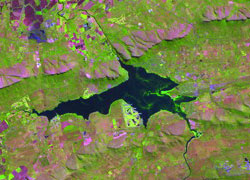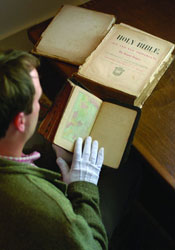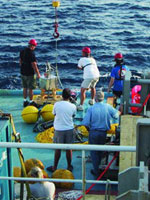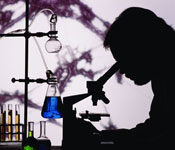
Fighting destructive crop fungi, understanding William Faulkner’s Values, using remote sensing to safeguard water supplies, reducing deadly blood clots and more.
 The CenterStage Science kits are packed with materials to help children enjoy learning about science and how scientists work.
The CenterStage Science kits are packed with materials to help children enjoy learning about science and how scientists work.
“We believe this project helps teach children to behave as scientists,” Shaw says. “To complete the lessons, the children must make observations and predictions as well as keep track of data—the basics of what leading scientists do on a daily basis.”
Correlated to National Science Education Standards, the centers offer dozens of ready-to-use activities with all the hands-on materials needed. The product contains lessons on earth, life and physical sciences. After viewing a similar mathematics product at a national conference, Chessin and Shaw began developing CenterStage Science, working in elementary classrooms to see how students reacted.
“We simply want to help teachers teach science, and CenterStage Science is a quick and easy way to integrate core science into a teacher’s already busy day,” Chessin says.
For more information about CenterStage Science, visit www.etacuisenaire.com and click on the science link.

“Drinking green tea is still good for you,” says Yu-Dong Zhou, a molecular biologist at the National Center for Natural Products Research. “There are thousands of years of evidence on that, but the idea of taking the equivalent of hundreds of cups of tea a day is something that needs to be looked at carefully.”
In a study published in the Journal of Natural Products, Zhou and her colleagues examined the effect of high doses of the active ingredients in green tea extract on hypoxia-inducible factor-1, or HIF-1, a key regulator of how tumor cells adapt to low-oxygen conditions. They found that a component of green tea known as ECG activates HIF-1 when consumed in large quantities.
The active compounds in green tea could actually serve dual functions, inhibiting HIF-1 at low concentrations and activating it at higher doses, Zhou says. “At low concentrations, it doesn’t seem to have this potentially negative effect as we saw in the lab,” she says. “A lot more study needs to be done to see what the outcome will be in people who take high doses of these compounds.”
 Destructive fungi cause millions of dollars worth of crop damage annually.
Destructive fungi cause millions of dollars worth of crop damage annually.
The naturally occurring compound, called sampangine, was first patented by UM in 1990 as a treatment for human fungal infections but was never released pharmaceutically. Now, plant pathologist David Wedge of the ARS Natural Products Utilization Research Unit and UM pharmacognosist Dale Nagle have been issued a patent for sampangine and similar, related compounds as broad-spectrum, low-toxicity controls of fungal plant pathogens that threaten agriculture.
According to the new patent, sampangine-based compounds can control such fungi as Botrytis cinerea, which causes gray mold on tomatoes; Colletotrichum fragariae, which produces anthracnose crown rot and wilt in strawberry plants; C. gloeosporioides, which sickens numerous plants, including grapes, strawberries, citrus and papaya; and Fusarium oxysporum, which induces vascular wilt in crops such as potatoes, sugarcane and many ornamentals.
Sampangine can greatly help the country’s $31 billion minor crop industry. For example, recent studies in Louisiana verified that some Botrytis fungal strains resist fungicides commonly used against them, and sampangine shows potential for managing fungicide resistance.
“Few people realize this, but traffic fatalities are the No. 1 cause of death in the world; 1.2 million people die and many millions more are severely injured every year,” says Uddin, who helped organize a United Nations-sponsored conference on Sustainable Transportation in Developing Countries, held last year in Abu Dhabi, United Arab Emirates. “Transportation also has secondary impacts, with both the degradation of air quality and the lack of physical activity affecting people’s health.”
Uddin led a session on using remote sensing technologies to monitor air quality and served as rapporteur for another on health impacts of transportation.
“Many of the issues discussed are still problems here in the U.S.,” Uddin says. “But in the developing world, the exponential growth of motorized transportation without effective infrastructure or safety laws in place has made these issues doubly dangerous.”
“The bottom line is the system will improve patient care,” says Vickie Taylor, an infection-control nurse. “The Medical Center is so large that there is no way for us to pull the lab reports of patients and examine them all every day. With this system we will know if we have a cluster of a specific pathogen on a specific unit without having to pull and go through every lab report.”
The new technology—created by Salt Lake City medical informatics firm TheraDoc—“will significantly improve infection-control capabilities and decrease the amount of time it takes to identify and respond to infectious disease outbreaks within our hospitals and the surrounding communities,” says Dr. Stan Chapman, director of the Division of Infectious Diseases.
The system, acquired with a nearly $1 million grant from the Mississippi State Department of Health, also contains an artificial intelligence component that aids in the tracking of adverse drug events.
 Satellite images, such as this one of Hartbeespoort Lake, are helping researchers develop a system to warn people of contamination problems.
Satellite images, such as this one of Hartbeespoort Lake, are helping researchers develop a system to warn people of contamination problems.
Michelle Aten, a doctoral student in geology and geological engineering, recently visited South Africa to conduct fieldwork for an early warning system for lake eutrophication, the process by which lakes become contaminated with man-made nutrients like fertilizers, which increase algae production and can make the water unfit for drinking.
The project, which the UM Geoinformatics Center has coordinated with staff from NASA, Stennis Space Center and the South African Department of Water Affairs and Forestry, focuses on Roodeplat Lake and Hartbeespoort Lake, both near Pretoria. Using satellite imagery to complement field monitoring already in place, researchers hope to develop a eutrophication warning system. Initially, such a system would warn people about contaminated water, but the eventual goal is to arm decision makers with information they need to stop contamination through education and policy changes.
“This is just good science,” says Aten, associate director of the Geoinformatics Center. “We’re contributing not only to this particular community in Africa but also to the remote sensing community in the world.”
 Griffith examines Faulkner family Bibles recently returned to Rowan Oak.
Griffith examines Faulkner family Bibles recently returned to Rowan Oak.
According to a penciled inscription dated Oct. 1, 1904, inside the back cover of the Nobel Prize-winning author’s childhood Bible, Faulkner, while studying a Sunday school lesson, was asked what he’d rather have than anything else. The inscription states that after a few moments, Faulkner replied, “I’d rather have honor and do what’s right.”
“This inscription reveals Faulkner’s value system was in place by the time he was 7 years old,” says William Griffith, curator of Rowan Oak. “This theme that people want to do right is present throughout much of his novels.”
The inscription came to light following the donation of the author’s study Bible to Rowan Oak by his daughter, Jill Faulkner Summers. She returned the tattered and torn Bible at a dedication ceremony commemorating the reopening of the author’s estate following a three-year, $1.3 million restoration project.
Lisa Roy published her findings in “Inculcation, Bias and Viewpoint Discrimination in Public Schools,” a paper in the spring 2005 edition of Pepperdine Law Review. The article highlights race, politics and religion as areas of concern in public school attempts at indoctrination.
“The article acknowledges that student religious speech in public schools is more complicated than other types of speech because of the potential conflict with the First Amendment’s prohibition on government establishment of religion,” Roy says. It concludes, however, “that short of an actual violation of the First Amendment’s Establishment Clause, religious speech should be protected along with speech pertaining to politics and race.”
Roy argues that while school administrators may have legitimate reasons for limiting expression of certain viewpoints, they are likely to suppress students who resist orthodox religious teachings. Free expression in all three areas, she says, “can protect a student’s developing identity, preserving an area that the state is not permitted to invade.”
 MMRI researchers lower their vertical array sensors into the Mediterranean Sea off the coast of Italy.
MMRI researchers lower their vertical array sensors into the Mediterranean Sea off the coast of Italy.
The group took equipment designed to study Gulf of Mexico hydrate deposits to the volcanic slopes of Stromboli, an island just north of Sicily.
“The vertical array equipment works very well in the flat mud of the Gulf of Mexico, where we usually use it,” says Tom McGee, MMRI research professor. “But on those steep volcanic slopes, we had to set the equipment differently.”
MMRI Director Bob Woolsey says MMRI and the Hydrates Consortium plan to continue their collaborative research with the University of Rome.
“Our technology lends itself to monitoring earthquakes and volcanic slopes at risk for failure, such as avalanches above and beneath the sea,” Woolsey says. “With the current high level of interest in tsunamis and the like, we expect to continue this collaboration toward learning more about why these events occur.”
Dickey has been working to implement risk assessments one department at a time, and all UM hospitals and clinics should be participating by the end of this summer. “My purpose is to make sure patients are assessed for their risk and to make sure the patients receive appropriate prophylaxis to prevent a bad outcome,” she says.
DVT is a common medical condition where a thrombus, or blood clot, forms in a large vein, usually in the lower limbs, partially or completely blocking circulation. A potentially fatal complication is pulmonary embolism, where a clot or clot fragment breaks loose and migrates to the lungs, blocking a pulmonary artery. But with awareness of risk factors, recognition of symptoms and proper medical care, the risk of DVT can be reduced and successfully treated.
The groups receive funding to develop their research collaborations and capabilities. Approximately $50,000 in first-year funding is earmarked for these five projects, with about $40,000 in additional funding anticipated for those who proposed a second year, pending satisfactory results and reporting.
The groups were chosen from 17 proposals submitted to ORSP earlier this year. The goal is to foster collaboration and information exchange among researchers from different disciplines who share common interests and expertise. By supporting such groups, ORSP hopes to draw on faculty strengths, promote cross-disciplinary discussions and activities and help groups prepare for interdisciplinary research funding opportunities.
The first interdisciplinary working groups are

With a Phase I grant from the National Institutes of Health under the Small Business Technology Transfer program, the researchers are studying a highly purified, injectable form of the anti-infective drug amphotericin B. Amphotericin B is the therapeutic of choice for infectious-disease specialists in treating fungal infections, but it can produce serious side effects related to renal toxicity, often resulting in dosage limitations or discontinued use.
John Cleary of the School of Pharmacy and Stanley Chapman, M.D., and Robert Kramer of the UM Medical Center have developed what they believe is a purer and safer form of the anti-infective by eliminating fermentation contaminants.
The grant funds continued laboratory study over a 12-month period. Upon completion of this phase, CET and UM plan to seek additional NIH funding to study the drug’s efficacy in patients. CET has the option to license the patent-pending technology.
“We are excited to have the opportunity to continue this promising research,” said Barbara Wells, dean of the School of Pharmacy. “We believe this grant will be the first of many positive developments that will result from our research alliance with CET.”